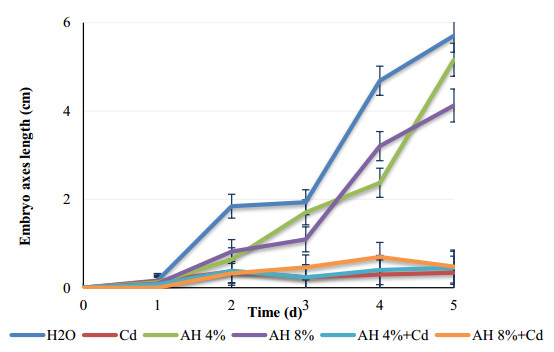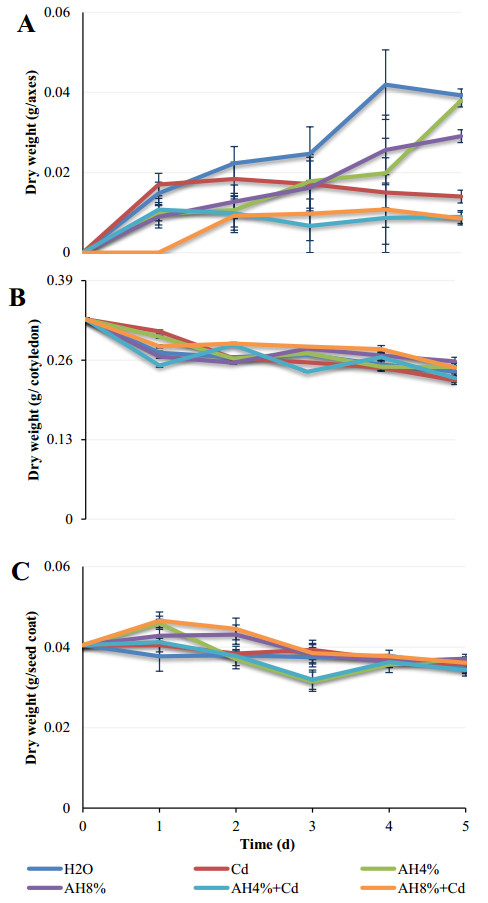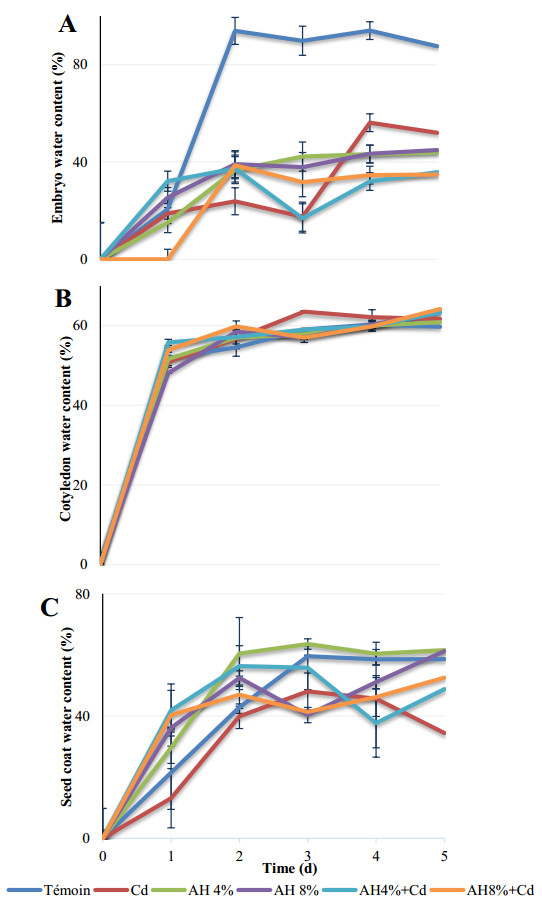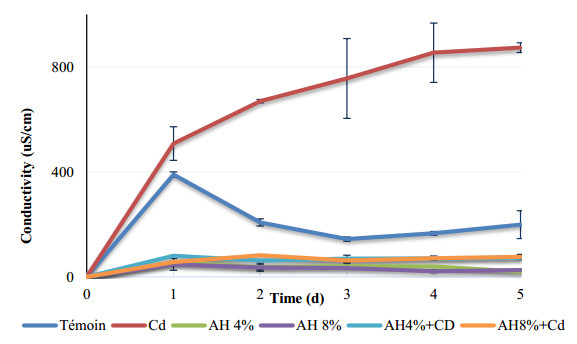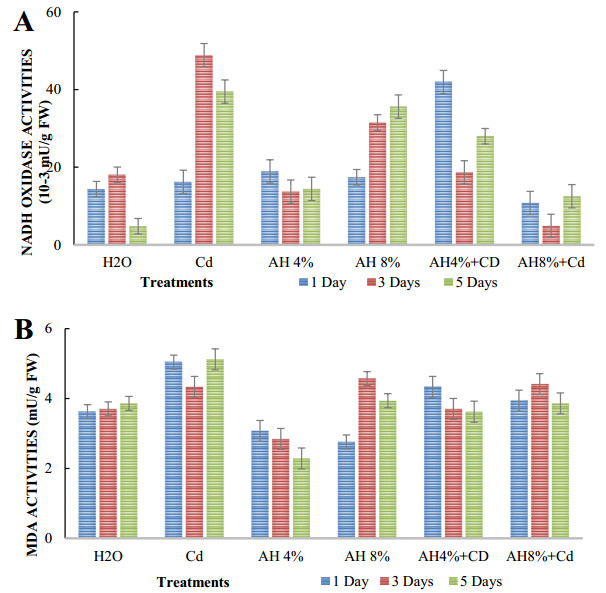1.
Introduction
The germination process consisted of three phases (1) the first phase, imbibition phase, corresponded to water absorption. Its duration varied from few hours to few days depending on the species [1], (2) the second phase, considered the most important because it determined the development of the seed. It is a stage of intense metabolic activities for gene expression and synthesis of enzymes that hydrolyze reserves for seedling development and (3) the third phase corresponds to the emergence of the root that preceded the establishment of seedlings [2]. Plants developed adaptive strategies to respond to chemical or physical environmental shocks by controlling and adjusting their metabolic system [3]. Cadmium, with high oxidation resistance, has an atomic number of 48 and an atomic mass of 112.4 g/mol [4]. In non-polluted soils, cadmium content is generally between 0.1 and 2 ppm and most of the time was less than 1 ppm [5]. Human practices (agricultural or industrial) also lead to soil enrichment with cadmium (Hashem et al. 2016b). Phytotoxic effects were manifested by growth inhibition resulted from numerous nutritional and metabolic dysfunctions [6].
Humic acids were structurally large macromolecular complexes with a brown-black appearance. They were soluble in water with pH greater than 2, and generally heterogeneous in structure and consist mainly of carbon, oxygen, hydrogen, nitrogen and occasionally Sulphur and phosphorus [7]. They described as assemblies of aromatic and aliphatic residues with carboxylic and phenolic groups. These were essentially carboxylic, phenolic, alcoholic, carbonyl, quinone, ketone and amine groups. Humic substances can form different types of complex with metals depending on the metal involved and its concentration [8]. The complexation of Cd, Cu and HgCH3 with humic functional groups was studied [9]. The effect of humic acid on germination and growth, reserve mobilisation, oxidative stress and antioxidant enzyme activities of pea (Pisum sativum L. var. Alicia) grown in water polluted with CdCl2 were examined in the present work.
2.
Materials and methods
Plant material and germination conditions: Seeds of pea (Pisum Sativum L. var. Alicia) were purchased from Space Green Company, Tunisia. Seeds were disinfected with 2% sodium hypochlorite for 10 min, rinsed thoroughly to remove disinfectant and soaked in distilled water at 4 ℃ for 30 min to obtain the initial stage. The same number of seeds (10 seeds per Petri dishes) were germinated in the dark at 24–26 ℃ over two sheets of filter paper imbibed with 10 mL of distilled water for 5 days, or a solution of 5 mM CdCl2 and/or two concentrations of humic acid (4% and 8%). Experimental studies of heavy metals impact on adult plants have often applied low concentrations. Nevertheless, high pollutant doses have been used in seed germination assays, although the germination is considered as a sensitive process as compared to other stages of plant development. This is explained, at least in part, by the fact that seed coasts may be impermeable to heavy metals. This can avoid an over accumulation of contaminant during the vital heterotrophic regime of germinating seed. Consequently, the behavior of seed germination is not regarded according to heavy metal doses in the seed surrounding medium, but considered with respect to the real accumulation and compartmentation of pollutant at cellular and subcellular levels [10].
Germination rate was calculated as a percentage of the control and germinating seed sampled for assays. Mean daily germination (MDG) was defined as the number of seed germinating per day relative to the maximum number of germinated seed. Germination speed was estimated by average time to germination of 50% of seed. At sampling, the seed coat was removed and embryonic axes were weighed and stored in liquid nitrogen until analysis, or dried for 8 days at 70 ℃ for dry weight determination. Embryonic axes were ground in a mortar with pestle in a medium (w/v = 1/5) containing 50 mM Tris-HCl (pH 8.0), 0.4 M sucrose, 1 mM EDTA, 5 mM ascorbic acid and 1 mM MgCl2. The homogenate was squeezed through double cheesecloth and centrifuged at 5000 × g for 20 min. The supernatant obtained was carefully decanted and used for GPOX, CAT and NADH oxidase assays.
All procedures were carried out at about 4 ℃. Solute leakage: the germination medium was analyzed for solute and electrolyte leakage. Special care was taken to remove most of the medium from the filter paper by folding the paper and applying pressure. Electrolyte leakage measurements were assayed with a conductivity meter (Model 250, Denver Instrument). The electrical conductivity was expressed on the basis of seed number [11]. Blanks containing water or 25%, 50%, or 100% effluent were included.
Enzyme activities (GPOX, CAT and NADH oxidase) were expressed as units per gram of fresh weight (U g-1 FW) and were detected using an Ultraviolet–Visible spectrophotometer (Lamba 2, PerkinElmer). Lipid peroxidation was estimated by determining the concentration of MDA [12]. Fresh samples (250 mg) were homogenized in 2 mL of 0.1% trichloroacetic acid (TCA). The homogenate was squeezed through double cheesecloth and centrifuged at 3,000×g for 15 min. All operations were performed at 4 ℃. A 0.5 mL aliquot of the supernatant was mixed with 1.5 mL of 0.5% thiobarbituric acid (TBA) prepared in TCA (20%), and the mixture was incubated at 90 ℃ for 20 min. After blocking the reaction in an ice bath, samples were centrifuged at 10,000×g for 5 min. The absorbance of the supernatant was then measured at 532 nm. After subtracting the non-specific absorbance at 600 nm, the MDA concentration was determined using the extinction coefficient of 155 mM-1 cm-1. Each treatment consisted of five replicates, and each experiment was carried out at least twice. All data were statistically analyzed using two-way NOVA, and the means were separated using Newman–Keuls multiple-range test (Statistica 8, StatSoft Co., USA). Differences were considered significant at P < 0.05.
3.
Results and discussion
3.1. Effect of Cadmium and humic acid on germination rate
The results presented in Figure 1 showed that germination process was vulnerable to cadmium enrichment of imbibition medium. The germination rate of cadmium-soaked seeds decreased significantly by 44%, while the germination rate of cadmium-soaked seeds with AH4%, AH8%, AH4%+Cd and AH8%+Cd showed significant increases by 89%, 100%, 72% and 55% respectively, compared to controls after 5 days of seed imbibition. Sensitivity to cadmium varies among species and even among cultivars during germination [13], but humic treatments increased the germination rate of Cadmium/HA-treated seeds (Figure 1). HA have significant effects on rhizogenesis, increased the number and length of roots at low concentrations (50–100 mg/L), increased fresh and dry weight of root and shoots [14] and increased cell elongation, but inhibited germination and growth at concentrations greater than (500–5000 mg/L) [15].
3.2. Effect of Cadmium and humic acid on pea seedling growth
Germination stimulated considerably the embryonic axes length of seedlings soaked with H2O. The length of embryonic axes of seeds soaked by Cd, AH4%+Cd and AH8%+Cd decreased by 10%, 11% and 12% but increased significantly by 102% and 72% after imbibition with AH4% and AH8%, respectively, compared to controls after 5 days of seed germination (Figure 2). Figure 3 showed that presence of cadmium in the imbibition medium significantly reduced dry weight from pea embryo, but increased in presence of HA. Results showed progressive increases in dry weight of embryonic axes soaked with AH4% and AH8% of (133% and 102%, respectively) and significant decrease in dry weight of embryonic axes soaked with Cd, AH4%+Cd and AH8%+Cd (1%, 8% and 5%) compared with controls after 5 days of germination (Figure 3). A gradual increase in dry weight from cadmium-soaked walls, AH4%, AH8%, AH4%+Cd and AH8%+Cd by about (102%, 107%, 106%, 99% and 104%, respectively) and in dry weight of cotyledons soaked with Cd, AH4%, AH8%, AH4%+Cd and AH8%+Cd (94%, 103%, 106%, 93% and 102%) respectively, compared with control after 5 days of germination. Several studies showed that presence of cadmium in the culture medium caused inhibition of plant growth [2]. Growth inhibitions were accompanied with important anatomical, structural and ultrastructural changes in leaves stems and roots. Regarding method application, humic substances improved plant growth by inducing quantitative increase in the length, surface, volume or weight of plant organs. These changes are observed on root growth through the appearance and elongation of new roots. There was an optimal application concentration varied between plant species [8].
3.3. Effect of Cadmium and humic acid on water absorption
Results presented in Figure 4 showed disorder in water absorption after treatment with humic acid and/or cadmium. A decrease in water content of plant treated with Cd, AH4%, AH8%, AH4%+Cd and AH8%+Cd by about (59%, 50%, 51%, 40% and 39%, respectively) compared to controls after 5 days of germination, but without effects on water content of treated cotyledons and seed coats compared to controls. HA improved water deficit. Germination process was initiated by water absorption. This was particularly dependent on the permeability of (1) seed tissues, (2) seed/substrate contact surface and (3) water conductivity of medium. Water deficit is a permanent constraint on agricultural production [16]. It affected plant growth and development, biomass and crop yield. During seed germination, water deficit caused decrease on growth [17] and disturbance in reserve mobilization [18]. It has been documented that cadmium affects water absorption and transport by decrease in relative water content, water potential (ψ), and foliar turgescence potential [19].
3.4. Effect of Cadmium and humic acid on cell transport
Cell transport, which was determined in the germination medium, by quantifying solute leakage. The results presented in Figure 5 showed low values of solute leakage during seed imbibition with H2O. The conductivity was significantly disturbed by Cd. Cadmium-soaked seeds have higher solute leakage than treatments with AH4%, AH8%, AH4%+Cd and AH8%+Cd. Several studies have shown that humic substances promote the removal of minerals from plants [20]. Absorption of macroelements (N, P, K, Mg, Ca) and micro-elements (Cu, Fe, Zn.) increased in presence of humic acids [21], fulvic acids [22], compost [23] or leonardite [24]. These effects of HA were observed for plants grown in soil [25] or in nutrient solution [26]. Humic substances affected fertility and mineral reserves by dissolution of macroelements, wich induced plant growth due to synergistic effect of these two types of compounds [27].
3.5. Effects of Cadmium and humic acid of oxidative stress
NADH oxidase activities were considered as marker of oxidative stress. At the beginning of germination, oxidase activities were higher than that after five days. The addition of Cd stimulated NADH oxidase activities from seeds compared with controls, but decreased in presence of combined solutions (Cd + AH) (Figure 6). Excessive NADH oxidase activities proved the install of oxidative stress in Cd poisoned seeds. MDA activities from seeds were substantially increased compared with controls (40%), but decreased in presence of AH (Figure 7). Important implication of these findings was that AH treatment significantly decreased MDA activities, which resulted in marked decrease in lipid peroxidation. Reactive oxygen species (ROS) were usually produced by cellular activity, but their levels were increased under stress [28]. Several studies have shown that cadmium induced oxidative stress in plants [29]. Indeed, cadmium produced free radicals, like superoxide ion (O2), hydrogen peroxide (H2O2), hydroxyl radical (OH) and singlet oxygen (O2). At the beginning of germination, guaiacol peroxidase activities were higher than that after five days of imbibition of seeds with H2O (Figure 7). Treatment of seeds with Cd and/or AH maintained a hight levels of guaiacol peroxidase activities during five days. The possible implication of GPOX against Cd toxicity and the improve of antioxidant system after AH treatment proved an important implication of these findings during germination. Catalase activities were induced by germination process in pea seeds, but significantly inhibited after treatment with Cd and/or AH (Figure 7). Oxidative stress disturbed enzymatic and non-enzymatic defense systems, such as catalase (CAT), acrobat peroxidase (APOX), glutathione reductase (GR) and peroxidase (POD) of plants. Antioxidant systems eliminated and/or neutralized free radicals. Heavy metals such as Cu, Cd didn't act directly on ROS production by Fenton-type reactions (H2O2 + Fe2+ •OH + OH- + Fe3+)
[30]. Responses varied depending on plant species, organ, age and concentration of cadmium [31]. Cadmium increases lipid peroxidation in Pisum sativum [32],
Oryza sativa [33], Brassica napus [34] and Lepidium sativum
[29]. H2O2 accumulations were detected in leaves of different plant species after exposure to Cd, such as Pisum sativum [35],
Brassica juncea [36] and Vigna mungo [31]. Balestrasse et al. [37] also reported that Cd stimulated accumulation of H2O2 and O2 in soybean leaves. Guo et al. [38] reported that exposure to 50 mM of Cd significantly increased H2O2 content in Oryza sativa roots. New approaches were developed to understand the effects of HA on cellular mechanisms [39]. Humic acids have a profound effect on the speciation and mobility of heavy metals [40]. HA provided important interfaces for the sorption of Cd [41]. Organic matter contributed by 25–90% of cationic exchange capacity of mineral from soil surface horizons [5]. Application of organic matter increased CEC and therefore increased adsorption of Cd in soils [42].
4.
Conclusions
The aim of wok was to highlight cadmium toxicity on different tissues from pea seeds (Pisum sativum L. var. Alicia) and to improve the interaction between HA and Cd treatments. We have tried with different doses of Cd and humic acid and for different treatment times. The presence of cadmium in soaking medium of pea seeds caused delay in germination rate. Seedling development was significantly affected by Cd, but stimulated with humic acid. Seed Responses concerned embryo growth and biomass. Solute leakage, which was determined in the imbibition medium, was very low during seed imbibition with H2O and HA, but increased in presence of cadmium. A hight level of solute leakage due to presence of cadmium in the imbibition medium improved the disturbance in reserve mobilization of cotyledons and embryonic axes. Reserve mobilization characterized germination process. Observed delay in germination rate could be explained, partially, by disturbance in mobilization of water and nutrients. At the beginning of germination, oxidase activities were higher than that after five days. NADH oxidase- and MDA- activities were considered as markers of oxidative stress. they were substantially increased after Cd-treatment compared with controls, but decreased in presence of AH. Excessive NADH oxidase activities proved the install of oxidative stress in Cd poisoned seeds. We suggested an antagonist effect of Cd and HA on oxidative stress enzyme activities. Treatment of seeds with Cd and/or AH maintained a hight levels of guaiacol peroxidase activities during five days. The possible implication of GPOX against Cd toxicity and the improve of antioxidant system after AH treatment proved an important implication of these findings during germination.
Acknowledgments
The author thanks Dr. Moêz Smiri (Shaqra University) for help on plant material selection and for discussion. All data generated or analyzed during this study are included in this published article. No funding was received.
Conflict of interest
The author declare that they have no conflict of interest
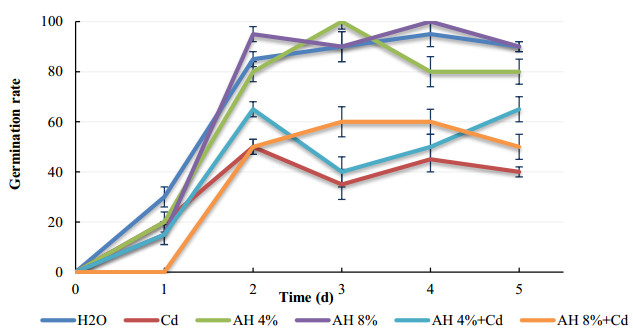









 DownLoad:
DownLoad:
